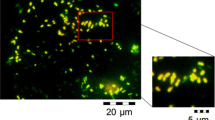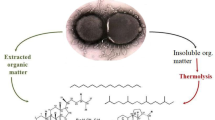Abstract
A screening identified several bacteria that were able to use chemically heterogeneous low-rank coal liquefaction products as complex carbon sources for growth. Pseudomonas oleovorans and Rhodococcus ruber accumulated polyhydroxyalkanoic acids (PHA) amounting to 2%–8% of the cell dry weight when the cells were cultivated on these liquefaction products in the absence of any other carbon source. R. ruber accumulated, in addition to PHA, small amounts of triacylglycerols. The accumulated PHA consisted of 3-hydroxyhexanoate, 3-hydroxydecanoate, and 3-hydroxydodecanoate (P. oleovorans) or 3-hydroxybutyric acid and 3-hydroxyvaleric acid (R. ruber). Low-rank coal liquefaction products obtained from Trichoderma atroviride were better substrates for P. oleovorans than chemically produced fulvic acids.
Similar content being viewed by others
Author information
Authors and Affiliations
Additional information
Received: 13 May 1998 / Received revision: 11 August 1998 / Accepted: 12 August 1998
Rights and permissions
About this article
Cite this article
Füchtenbusch, B., Steinbüchel, A. Biosynthesis of polyhydroxyalkanoates from low-rank coal liquefaction products by Pseudomonas oleovorans and Rhodococcus ruber . Appl Microbiol Biotechnol 52, 91–95 (1999). https://doi.org/10.1007/s002530051492
Issue Date:
DOI: https://doi.org/10.1007/s002530051492




